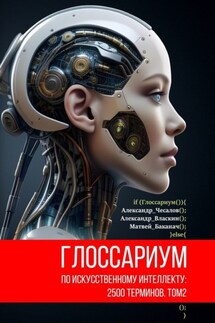Глоссариум по искусственному интеллекту: 2500 терминов. Том 2 - страница 12
Assistive intelligence is AI-based systems that help make decisions or perform actions.
Association for the Advancement of Artificial Intelligence (AAAI) is an international, nonprofit, scientific society devoted to promote research in, and responsible use of, artificial intelligence. AAAI also aims to increase public understanding of artificial intelligence (AI), improve the teaching and training of AI practitioners, and provide guidance for research planners and funders concerning the importance and potential of current AI developments and future directions96.
Association is another type of unsupervised learning method that uses different rules to find relationships between variables in a given dataset. These methods are frequently used for market basket analysis and recommendation engines, along the lines of «Customers Who Bought This Item Also Bought» recommendations97.
Association Rule Learning is a rule-based Machine Learning method for discovering interesting relations between variables in large data sets98.
Asymptotic computational complexity in computational complexity theory, asymptotic computational complexity is the usage of asymptotic analysis for the estimation of computational complexity of algorithms and computational problems, commonly associated with the usage of the big O notation99.
Asynchronous inter-chip protocols are protocols for data exchange in low-speed devices; instead of frames, individual characters are used to control the exchange of data100.
Attention mechanism is one of the key innovations in the field of neural machine translation. Attention allowed neural machine translation models to outperform classical machine translation systems based on phrase translation. The main bottleneck in sequence-to-sequence learning is that the entire content of the original sequence needs to be compressed into a vector of a fixed size. The attention mechanism facilitates this task by allowing the decoder to look back at the hidden states of the original sequence, which are then provided as a weighted average as additional input to the decoder101.
Attributional calculus (AC) is a logic and representation system defined by Ryszard S. Michalski. It combines elements of predicate logic, propositional calculus, and multi-valued logic. Attributional calculus provides a formal language for natural induction, an inductive learning process whose results are in forms natural to people102.
Augmented Intelligence is the intersection of machine learning and advanced applications, where clinical knowledge and medical data converge on a single platform. The potential benefits of Augmented Intelligence are realized when it is used in the context of workflows and systems that healthcare practitioners operate and interact with. Unlike Artificial Intelligence, which tries to replicate human intelligence, Augmented Intelligence works with and amplifies human intelligence103.
Augmented reality (AR) is an interactive experience of a real-world environment where the objects that reside in the real-world are «augmented» by computer-generated perceptual information, sometimes across multiple sensory modalities, including visual, auditory, haptic, somatosensory, and olfactory104.
Augmented reality technologies are visualization technologies based on adding information or visual effects to the physical world by overlaying graphic and/or sound content to improve user experience and interactive features









